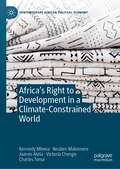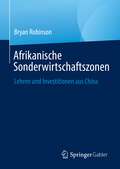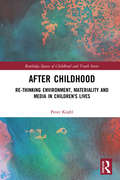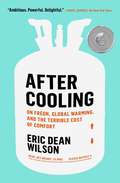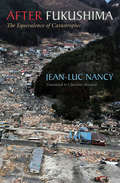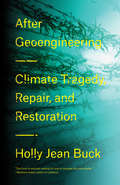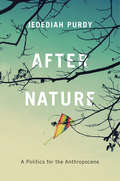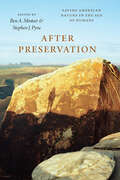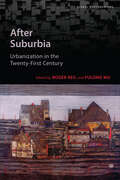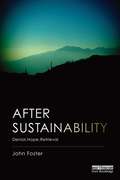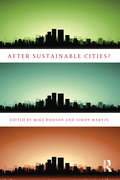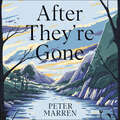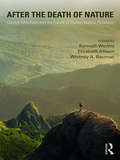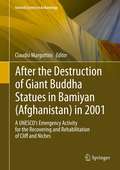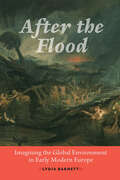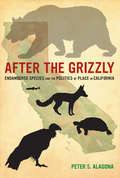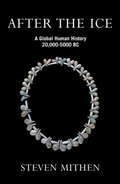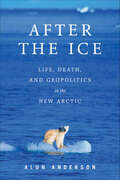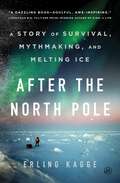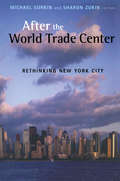- Table View
- List View
Africa’s Right to Development in a Climate-Constrained World (Contemporary African Political Economy)
by Kennedy Mbeva Reuben Makomere Joanes Atela Victoria Chengo Charles TonuiThis book examines how Africa can secure a ‘just transition’ to low-carbon, climate-resilient economies.
Afrikanische Sonderwirtschaftszonen: Lehren und Investitionen aus China
by Bryan RobinsonDieses Buch bewertet afrikanische Sonderwirtschaftszonen aus einer Perspektive der Lehren und Erfahrungen, die China mit solchen Zonen gemacht hat, deren Auswirkungen auf die chinesische Politik und auf Investitionen.Unter Verwendung von Fallstudien über als erfolgreich wahrgenommene Sonderwirtschaftszonen in China, wird das chinesische Modell dieser Zonen als Bewertungs- und Benchmarking-Instrument vorgeschlagen, mit dem afrikanische Sonderwirtschaftszonen verglichen werden.Anhand mehrerer Fallstudien zu afrikanischen Sonderwirtschaftszonen wird im Buch die Wettbewerbsfähigkeit dieser mit besonderem Augenmerk auf die Anwerbung chinesischer Investoren für diese Zonen untersucht. Die wirtschaftlichen, sozialen und ökologischen Auswirkungen dieser Zonen werden bewertet. Die Bemühungen afrikanischer Staaten erfolgreiche Sonderwirtschaftszonen zu ermöglichen oder dies nicht zu tun, werden kritisch analysiert.Schließlich werden die Sonderwirtschaftszonen in Afrika mit dem chinesischen Modell verglichen, und es wird ein afrikanisches Modell für Sonderwirtschaftszonen vorgeschlagen. Es werden Empfehlungen an die Führung der afrikanischen Staaten sowie an chinesische Entscheidungsträger und Investoren gegeben, wie diese Zonen verbessert werden können, um die Wettbewerbsfähigkeit zu steigern und die Ziele der nachhaltigen Entwicklung der Zonen zu erreichen. Bryan Robinson ist wissenschaftlicher Mitarbeiter und Senior Lecturer an der Nelson Mandela University Business School, Port Elizabeth, Südafrika.Dieses Buch stellt die Übersetzung einer englischsprachigen Originalausgabedar. Die Übersetzung wurde mit Hilfe von künstlicher Intelligenz erstellt (maschinelle Übersetzung mit DeepL.com). Eine anschließende manuelle Überarbeitung erfolgte vor allem nach inhaltlichen Gesichtspunkten, so dass sich das Buch stilistisch von einer herkömmlichen Übersetzung abweicht.
After Childhood: Re-thinking Environment, Materiality and Media in Children's Lives (Routledge Spaces of Childhood and Youth Series)
by Peter KraftlThis book offers a new approach for theorising and undertaking childhood research. It combines insights from childhood and generational studies with object-oriented ontologies, new materialisms, critical race and gender theories to address a range of key, intractable challenges facing children and young people. Bringing together traditional social-scientific research methods with techniques from digital media studies, archaeology, environmental nanoscience and the visual arts, After Childhood: Re-thinking Environment, Materiality and Media in Children's Lives presents a way of doing childhood research that sees children move in and out of focus. In doing so, children and their experiences are not completely displaced; rather, new perspectives on concerns facing children around the world are unravelled which dominant approaches to childhood studies have not yet fully addressed. The book draws on the author’s detailed case studies from his research in historical and geographical contexts. Examples range from British children’s engagement with plastics, energy and other matter, to the positioning of diverse Brazilian young people in environmental and resource challenges, and from archaeological evidence about childhoods in the USA and Europe to the global circulation of children’s toys through digital media. The book will appeal to human geographers, sociologists, anthropologists, education studies scholars and others working in the interdisciplinary field of childhood studies, as well as to anyone looking for a range of novel, interdisciplinary frames for thinking about childhood.
After Cooling: On Freon, Global Warming, and the Terrible Cost of Comfort
by Eric Dean WilsonThis dazzlingly original work of literary nonfiction interweaves the science and history of the powerful refrigerant (and dangerous greenhouse gas) Freon with a haunting meditation on how to live meaningfully and morally in a rapidly heating world.In After Cooling, Eric Dean Wilson braids together air-conditioning history, climate science, road trips, and philosophy to tell the story of the birth, life, and afterlife of Freon, the refrigerant that ripped a hole larger than the continental United States in the ozone layer. As he traces the refrigerant&’s life span from its invention in the 1920s—when it was hailed as a miracle of scientific progress—to efforts in the 1980s to ban the chemical (and the resulting political backlash), Wilson finds himself on a journey through the American heartland, trailing a man who buys up old tanks of Freon stockpiled in attics and basements to destroy what remains of the chemical before it can do further harm. Wilson is at heart an essayist, looking far and wide to tease out what particular forces in American culture—in capitalism, in systemic racism, in our values—combined to lead us into the Freon crisis and then out. It&’s a story that offers a rare glimpse of environmental hope, suggesting that maybe the vast and terrifying problem of global warming is not beyond our grasp to face.
After Fukushima: The Equivalence of Catastrophes
by Jean-Luc NancyThe renowned philosopher offers &“a powerful reflection on our times . . . and the fate of our civilization, as revealed by the catastrophe of Fukushima&” (François Raffoul, Louisiana State University). In 2011, a tsunami flooded Japan&’s Fukushima Daiichi Nuclear Power Plant, causing three nuclear meltdowns, the effects of which will spread through generations and have an impact on all living things. In After Fukushima, philosopher Jean-Luc Nancy examines the nature of catastrophes in the era of globalization and technology. He argues that in today&’s interconnected world, the effects of any disaster will spread in the way we currently associate only with nuclear risk. Can a catastrophe be an isolated occurrence? Is there such a thing as a &“natural&” catastrophe when all of our technologies—nuclear energy, power supply, water supply—are necessarily implicated, drawing together the biological, social, economic, and political? In this provocative and engaging work, Nancy examines these questions and more. Exclusive to this English edition are two interviews with Nancy conducted by Danielle Cohen-Levinas and Yuji Nishiyama and Yotetsu Tonaki.
After Geoengineering: Climate Tragedy, Repair, and Restoration
by Holly Jean BuckWhat if the people seized the means of climate production?Climate engineering is a dystopian project. But as the human species hurtles ever faster towards its own extinction, geoengineering as a temporary fix, to buy time for carbon removal, is a seductive idea. We are right to fear that geoengineering will be used to maintain the status quo, but is there another possible future after geoengineering? Can these technologies and practices be used as technologies of repair, to bring carbon levels back down to pre-industrial levels? Are there possibilities for massive intentional intervention in the climate that are democratic, decentralized, or participatory? Is there a scenario where the people can define and enact geoengineering on our own terms? These questions are provocative, because they go against a binary that has become common sense: geoengineering is assumed to be on the side of industrial agriculture, inequality and ecomodernism, in opposition to degrowth, renewable energy, sustainable agriculture and climate justice. After Geoengineering rejects this binary, to ask: what if the people seized the means of climate production? Both critical and utopian, the book examines the possible futures after geoengineering. Rejecting the idea that geoengineering is some kind of easy work-around, Holly Buck outlines the kind of social transformation that would be necessary to enact a programme of geoengineering in the first place.
After Nature: A Politics for the Anthropocene
by Jedediah PurdyNature no longer exists apart from humanity. The world we will inhabit is the one we have made. Geologists call this epoch the Anthropocene, Age of Humans. The facts of the Anthropocene are scientific--emissions, pollens, extinctions--but its shape and meaning are questions for politics. Jedediah Purdy develops a politics for this post-natural world.
After Nature: A Politics for the Anthropocene
by Jedediah PurdyNature no longer exists apart from humanity. Henceforth, the world we will inhabit is the one we have made. Geologists have called this new planetary epoch the Anthropocene, the Age of Humans. The geological strata we are now creating record industrial emissions, industrial-scale crop pollens, and the disappearance of species driven to extinction. Climate change is planetary engineering without design. These facts of the Anthropocene are scientific, but its shape and meaning are questions for politics - a politics that does not yet exist. After Nature develops a politics for this post-natural world.
After Preservation: Saving American Nature in the Age of Humans
by Ben A. Minteer Stephen J. PyneFrom John Muir to David Brower, from the creation of Yellowstone National Park to the Endangered Species Act, environmentalism in America has always had close to its core a preservationist ideal. Generations have been inspired by its ethos--to encircle nature with our protection, to keep it apart, pristine, walled against the march of human development. But we have to face the facts. Accelerating climate change, rapid urbanization, agricultural and industrial devastation, metastasizing fire regimes, and other quickening anthropogenic forces all attest to the same truth: the earth is now spinning through the age of humans. After Preservation takes stock of the ways we have tried to both preserve and exploit nature to ask a direct but profound question: what is the role of preservationism in an era of seemingly unstoppable human development, in what some have called the Anthropocene? Ben A. Minteer and Stephen J. Pyne bring together a stunning consortium of voices comprised of renowned scientists, historians, philosophers, environmental writers, activists, policy makers, and land managers to negotiate the incredible challenges that environmentalism faces. Some call for a new, post-preservationist model, one that is far more pragmatic, interventionist, and human-centered. Others push forcefully back, arguing for a more chastened and restrained vision of human action on the earth. Some try to establish a middle ground, while others ruminate more deeply on the meaning and value of wilderness. Some write on species lost, others on species saved, and yet others discuss the enduring practical challenges of managing our land, water, and air. From spirited optimism to careful prudence to critical skepticism, the resulting range of approaches offers an inspiring contribution to the landscape of modern environmentalism, one driven by serious, sustained engagements with the critical problems we must solve if we--and the wild garden we may now keep--are going to survive the era we have ushered in. Contributors include: Chelsea K. Batavia, F. Stuart (Terry) Chapin III, Norman L. Christensen, Jamie Rappaport Clark, William Wallace Covington, Erle C. Ellis, Mark Fiege, Dave Foreman, Harry W. Greene, Emma Marris, Michelle Marvier, Bill McKibben, J. R. McNeill, Curt Meine, Ben A. Minteer, Michael Paul Nelson, Bryan Norton, Stephen J. Pyne, Andrew C. Revkin, Holmes Rolston III, Amy Seidl, Jack Ward Thomas, Diane J. Vosick, John A. Vucetich, Hazel Wong, and Donald Worster.
After Suburbia: Urbanization in the Twenty-First Century (Global Suburbanisms)
by Roger Keil Fulong WuAfter Suburbia presents a cross-section of state-of-the-art scholarship in critical global suburban research and provides an in-depth study of the planet’s urban peripheries to grasp the forms of urbanization in the twenty-first century. Based on cutting-edge conceptual thought and steeped in richly detailed empirical work conducted over the past decade, After Suburbia draws on research from Asia, Africa, Australia, Europe, and the Americas to showcase comprehensive global scholarship on the urban periphery. Contributors explicitly reject the traditional centre-periphery dichotomy and the prioritization of epistemologies that favour the Global North, especially North American cases, over other experiences. In doing so, the book strongly advances the notion of a post-suburban reality in which traditional dynamics of urban extension outward from the centre are replaced by a set of complex contradictory developments. After Suburbia examines multiple centralities and diverse peripheries which mesh to produce a surprisingly contradictory and diverse metropolitan landscape.
After Sustainability: Denial, Hope, Retrieval
by John FosterDangerous climate change is coming. Some people still deny that it is happening. Others refuse to recognise that it is now too late to prevent it. But both these reactions spring from the same source: our pathological attachment to ‘progress’, of which sustainability has been one more version. After Sustainability traces that attachment to its roots in the ways we make sense of ourselves. Original and accessible, this is philosophy on the edge, written for anyone who glimpses our environmental tragedy and cares about our future. Does the challenge to stop pretending offer our only remaining chance? Read this book and make up your own mind.
After Sustainable Cities?
by Simon Marvin Mike HodsonA sustainable city has been defined in many ways. Yet, the most common understanding is a vision of the city that is able to meet the needs of the present without compromising the ability of future generations to meet their own needs. Central to this vision are two ideas: cities should meet social needs, especially of the poor, and not exceed the ability of the global environment to meet needs.After Sustainable Cities critically reviews what has happened to these priorities and asks whether these social commitments have been abandoned in a period of austerity governance and climate change and replaced by a darker and unfair city. This book provides the first comprehensive and comparative analysis of the new eco-logics reshaping conventional sustainable cities discourse and environmental priorities of cities in both the global north and south. The dominant discourse on sustainable cities, with a commitment to intergenerational equity, social justice and global responsibility, has come under increasing pressure. Under conditions of global ecological change, international financial and economic crisis and austerity governance new eco-logics are entering the urban sustainability lexicon – climate change, green growth, smart growth, resilience and vulnerability, ecological security. This book explores how these new eco-logics reshape our understanding of equity, justice and global responsibility, and how these more technologically and economically driven themes resonate and dissonate with conventional sustainable cities discourse. This book provides a warning that a more technologically driven and narrowly constructed economic agenda is driving ecological policy and weakening previous commitment to social justice and equity. After Sustainable Cities brings together leading researchers to provide a critical examination of these new logics and identity what sort of city is now emerging, as well as consider the longer-term implication on sustainable cities research and policy.
After They're Gone: Extinctions Past, Present and Future
by Peter Marren'Wise, challenging and offering some unexpected laughter in the dark, this is a rational and insightful account of the sixth great extinction event. Peter Marren is a brilliant writer and a national treasure.' PATRICK BARKHAM'Thoughtful, fascinating and very timely.' STEPHEN MOSS'Important and thought-provoking.' CAROLINE LUCAS, GREEN PARTY MP'Essential reading. Marren makes a page-turner out of Armageddon.' SIMON BARNES'In his characteristic style Peter Marren has humanised the story of wildlife losses with humour and wit but also with his enormous knowledge and deep love for the living world.' MARK COCKERWe are in the midst of an extinction event: the sixth mass extinction on earth and one entirely caused by mankind. All species become extinct sooner or later, but we have accelerated that natural process several hundredfold and now, it is happening right in front of our eyes. Extinction has a terrifying finality to it. And many species have already been lost to us forever; there is little we can do about that.What we can do, however, is reflect, remember, and ultimately acknowledge the unvarnished truth. We must see the natural world as it is, and not as we might want it to be. Our trajectory is one that has benefited one species alone - humankind. For all other beings, from mammals to fish, from birds to insects and coral, from plants to lichens and fungi, the future, for better or worse, is in our hands.
After They're Gone: Extinctions Past, Present and Future
by Peter Marren'Wise, challenging and offering some unexpected laughter in the dark, this is a rational and insightful account of the sixth great extinction event. Peter Marren is a brilliant writer and a national treasure.' PATRICK BARKHAM'Thoughtful, fascinating and very timely.' STEPHEN MOSS'Important and thought-provoking.' CAROLINE LUCAS, GREEN PARTY MP'Essential reading. Marren makes a page-turner out of Armageddon.' SIMON BARNES'In his characteristic style Peter Marren has humanised the story of wildlife losses with humour and wit but also with his enormous knowledge and deep love for the living world.' MARK COCKERWe are in the midst of an extinction event: the sixth mass extinction on earth and one entirely caused by mankind. All species become extinct sooner or later, but we have accelerated that natural process several hundredfold and now, it is happening right in front of our eyes. Extinction has a terrifying finality to it. And many species have already been lost to us forever; there is little we can do about that.What we can do, however, is reflect, remember, and ultimately acknowledge the unvarnished truth. We must see the natural world as it is, and not as we might want it to be. Our trajectory is one that has benefited one species alone - humankind. For all other beings, from mammals to fish, from birds to insects and coral, from plants to lichens and fungi, the future, for better or worse, is in our hands.
After They're Gone: Extinctions Past, Present and Future
by Peter MarrenThe past, present and future of extinction from a world-leading naturalist.We are in the midst of an extinction event: the sixth mass extinction on earth and one entirely caused by mankind. All species become extinct sooner or later, but we have accelerated that natural process several hundredfold and now, it is happening right in front of our eyes. Extinction has a terrifying finality to it. And many species have already been lost to us forever; there is little we can do about that.What we can do, however, is reflect, remember, and ultimately acknowledge the unvarnished truth. We must see the natural world as it is, and not as we might want it to be. Our trajectory is one that has benefited one species alone - humankind. For all other beings, from mammals to fish, from birds to insects and coral, from plants to lichens and fungi, the future, for better or worse, is in our hands.'Wise, challenging and offering some unexpected laughter in the dark, this is a rational and insightful account of the sixth great extinction event. Peter Marren is a brilliant writer and a national treasure.' PATRICK BARKHAM'Thoughtful, fascinating and very timely.' STEPHEN MOSS'Important and thought-provoking.' CAROLINE LUCAS, GREEN PARTY MP'Essential reading. Marren makes a page-turner out of Armageddon.' SIMON BARNES'In his characteristic style Peter Marren has humanised the story of wildlife losses with humour and wit but also with his enormous knowledge and deep love for the living world.' MARK COCKER(P) 2022 Hodder & Stoughton Limited
After the Death of Nature: Carolyn Merchant and the Future of Human-Nature Relations
by Kenneth Worthy Whitney A. Bauman Elizabeth AllisonCarolyn Merchant’s foundational 1980 book The Death of Nature: Women, Ecology, and the Scientific Revolution established her as a pioneering researcher of human-nature relations. Her subsequent groundbreaking writing in a dozen books and over one hundred peer-reviewed articles have only fortified her position as one of the most influential scholars of the environment. This book examines and builds upon her decades-long legacy of innovative environmental thought and her critical responses to modern mechanistic and patriarchal conceptions of nature and women as well as her systematic taxonomies of environmental thought and action. Seventeen scholars and activists assess, praise, criticize, and extend Merchant’s work to arrive at a better and more complete understanding of the human place in nature today and the potential for healthier and more just relations with nature and among people in the future. Their contributions offer personal observations of Merchant’s influence on the teaching, research, and careers of other environmentalists.
After the Destruction of Giant Buddha Statues in Bamiyan: A UNESCO's Emergency Activity for the Recovering and Rehabilitation of Cliff and Niches (Natural Science in Archaeology #Vol. 17)
by Claudio MargottiniThis work reports on a real adventure in earth science and conservation, dealing with the UNESCO's emergency activities implemented in Bamiyan (Central Afghanistan) for the recovery and rehabilitation of the cliff and niches after the destruction of the two famous Giant Statues in 2001. Since 2002 an international effort has been made to understand the geological characteristics of the area, the mechanical properties of local materials, petro-geophysical and sedimentological details as well as the historical and geological evolution of the Statues and cliff. Taken together, this information serves as a basis for the recovery and rehabilitation of the cliff and niches and is presented in detail.
After the Flood: Imagining the Global Environment in Early Modern Europe
by Lydia BarnettHow the story of Noah's Flood was central to the development of a global environmental consciousness in early modern Europe.Winner of the Morris D. Forkosch Prize by the Journal of the History of Ideas, Short-listed for the Kenshur Prize by the Center for Eighteenth-Century Studies, Indiana UniversityMany centuries before the emergence of the scientific consensus on climate change, people began to imagine the existence of a global environment: a natural system capable of changing humans and of being changed by them. In After the Flood, Lydia Barnett traces the history of this idea back to the early modern period, when the Scientific Revolution, the Reformations, the Little Ice Age, and the overseas expansion of European empire, religion, and commerce gave rise to new ideas about nature and humanity, and their intersecting histories. Recovering a forgotten episode in the history of environmental thought, Barnett brings to light the crucial role of religious faith and conflict in fostering new ways of thinking about the capacity of humans and nature to change each other on a planetary scale. In the hands of Protestant and Catholic writers from across Europe and its American colonies, the biblical story of Noah's Flood became a vehicle for imagining the power of sin to wreck the world, the dangers of overpopulation, the transformative effects of shifting landforms on the course of human history, and the impact of a changing climate on human bodies, health, and lives. Following Noah's Flood as a popular topic of debate through long-distance networks of knowledge from the late sixteenth through the early eighteenth centuries, Barnett reveals how early modern earth and environmental sciences were shaped by gender, evangelism, empire, race, and nation. After the Flood illuminates the hidden role and complicated legacy of religion in the emergence of a global environmental consciousness.
After the Grizzly: Endangered Species and the Politics of Place in California
by Peter S. AlagonaThoroughly researched and finely crafted, After the Grizzly traces the history of endangered species and habitat in California, from the time of the Gold Rush to the present. Peter S. Alagona shows how scientists and conservationists came to view the fates of endangered species as inextricable from ecological conditions and human activities in the places where those species lived. Focusing on the stories of four high-profile endangered species--the California condor, desert tortoise, Delta smelt, and San Joaquin kit fox--Alagona offers an absorbing account of how Americans developed a political system capable of producing and sustaining debates in which imperiled species serve as proxies for broader conflicts about the politics of place. The challenge for conservationists in the twenty-first century, this book claims, will be to redefine habitat conservation beyond protected wildlands to build more diverse and sustainable landscapes.
After the Ice Age: The Return of Life to Glaciated North America
by E. C. PielouThe fascinating story of how a harsh terrain that resembled modern Antarctica has been transformed gradually into the forests, grasslands, and wetlands we know today. "One of the best scientific books published in the last ten years. "-Ottowa Journal "A valuable new synthesis of facts and ideas about climate, geography, and life during the past 20,000 years. More important, the book conveys an intimate appreciation of the rich variety of nature through time. "-S. David Webb,Science
After the Ice: A Global Human History, 20,000 - 5000 BC
by Prof Steven MithenA fantastic voyage through 15,000 years of history that laid the foundations for civilisation as we know it by award-winning science writer Steven Mithen.Twenty thousand years ago Earth was in the midst of an ice age. Then global warming arrived, leading to massive floods, the spread of forests and the retreat of the deserts. By 5,000 BC a radically different human world had appeared. In place of hunters and gatherers there were farmers; in place of transient campsites there were towns. The foundations of our modern world had been laid and nothing that came after - the Industrial Revolution, the atomic age, the internet - have ever matched the significance of those events. AFTER THE ICE tells the story of climate change's impact during this momentous period - one that also saw the colonisation of the Americas and mass extinctions of animals throughout the world. Drawing on the latest cutting-edge research in archaeology, cognitive science, palaeontology, geology and the evolutionary sciences, Steven Mithen creates an evocative, original and remarkably complete picture of minds, cultures, lives and landscapes through 15,000 years of history.
After the Ice: A Global Human History, 20,000 - 5000 BC
by Steven MithenA fantastic voyage through 15,000 years of history that laid the foundations for civilisation as we know it by award-winning science writer Steven Mithen.Twenty thousand years ago Earth was in the midst of an ice age. Then global warming arrived, leading to massive floods, the spread of forests and the retreat of the deserts. By 5,000 BC a radically different human world had appeared. In place of hunters and gatherers there were farmers; in place of transient campsites there were towns. The foundations of our modern world had been laid and nothing that came after - the Industrial Revolution, the atomic age, the internet - have ever matched the significance of those events. AFTER THE ICE tells the story of climate change's impact during this momentous period - one that also saw the colonisation of the Americas and mass extinctions of animals throughout the world. Drawing on the latest cutting-edge research in archaeology, cognitive science, palaeontology, geology and the evolutionary sciences, Steven Mithen creates an evocative, original and remarkably complete picture of minds, cultures, lives and landscapes through 15,000 years of history.
After the Ice: Life, Death, and Geopolitics in the New Arctic
by Alun AndersonNew from Smithsonian Books, After the Ice is an eye-opening look at the winners and losers in the high-stakes story of Arctic transformation, from nations to native peoples to animals and the very landscape itself. Author Alun Anderson explores the effects of global warming amid new geopolitical rivalries, combining science, business, politics, and adventure to provide a fascinating narrative portrait of this rapidly changing land of unparalleled global significance.
After the North Pole: A Story of Survival, Mythmaking, and Melting Ice
by Erling KaggeThe Norwegian explorer, philosopher and acclaimed writer tells of his historic 58-day journey to the North Pole on skis in this provocative memoir that is a profound meditation on nature and the history of explorers' obsession. The North Pole looms large in our collective psyche—the ultimate Otherland in a world mapped and traversed. It is the center of our planet’s rotation, one of the places that is most vulnerable in an epoch of global climate change. Its sub-zero temperatures and strange year of one sunset and one sunrise make it an eerie, utterly disorienting place that challenges human endurance and understanding.Erling Kagge and his friend Børge Ousland became the first people “to ever reach the pole without dogs, without depots and without motorized aids,” skiing for 58 days from a drop off point on the ice edge of Canada’s northernmost island.Erling describes his record-making journey, probing the physical challenges and psychological motivations for embarking on such an epic expedition, the history of the territory’s exploration, its place in legend and art, and the thrilling adventures he experienced during the trek. It is another example of what bestselling author Robert MacFarlane has called “Kagge’s extraordinary life in wild places,”Erling also observes the key role that this place holds in our current climate and geopolitical conversations. As majestic, mesmerizing, and monumental as the terrain it captures, After the North Pole is for anyone who has gazed out at the horizon—and wondered what happens if you keep going.After the North Pole is illustrated with 12-14 photographs.Translated from the Norwegian by Kari Dickson.
After the World Trade Center: Rethinking New York City (Cultural Spaces)
by Michael Sorkin Sharon ZukinThe terrorist attacks of September 11 have created an unprecedented public discussion about the uses and meanings of the central area of lower Manhattan that was once the World Trade Center. While the city sifts through the debris, contrary forces shaping its future are at work. Developers jockey to control the right to rebuild "ground zero." Financial firms line up for sweetheart deals while proposals for memorials are gaining in appeal. In After the World Trade Center, eminent social critics Sharon Zukin and Michael Sorkin call on New York's most acclaimed urbanists to consider the impact of the terrorist attack on the World Trade Center and what it bodes for the future of New York. Contributors take a close look at the reaction to the attack from a variety of New York communities and discuss possible effects on public life in the city.
